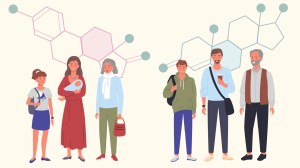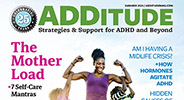Hormonal Changes & ADHD: A Lifelong Tug-of-War
As estrogen and testosterone levels rise and fall through each stage of life, ADHD symptoms swing with them, according to new ADDitude research on hormonal changes.

May 1, 2023
Hormonal fluctuations worsen symptoms of attention deficit hyperactivity disorder (ADHD) for men and women alike, and the severity grows more pronounced with age, according to a recent ADDitude survey of 1,829 adults with ADHD. Across genders, ADDitude readers almost equally cited progressively more debilitating challenges during the marked hormonal shifts of puberty, pregnancy, postpartum (the time after childbirth), perimenopause, menopause, and andropause (often called male menopause).
These findings suggest that the traditional view of ADHD — as a childhood disorder that resolves after puberty — was entirely backward.
In reality, both women and men with ADHD report the greatest symptom severity from ages 50 to 59 — during menopause and andropause, respectively. On a scale of 1 (minor impact) to 5 (life-altering), ADHD symptoms from age 50 to 59 earned a 4.24 rating from women and a 4.14 rating from men. In contrast, symptoms during childhood earned ratings of 2.79 and 2.9, respectively. Fading memories, late diagnoses, and recency, or availability bias, may factor into these ratings, but the stories shared by ADDitude readers support the idea that ADHD grows more pronounced — not less — with age.
“The reason so many women are not diagnosed until menopause and beyond is because estrogen falls, leaving our brains when we need it more than ever,” wrote one Californian diagnosed with ADHD at age 62. “Estrogen and dopamine go hand in hand — or, rather, synapse to receptor! Whatever dopamine you have in the center of your brain needs estrogen to get it moving to the frontal lobe, where executive function takes place. It’s a travesty that menopausal women are typically left to feel like we have finally lost our minds.”
Another interesting survey finding that contrasts with traditional thinking: The rate of inattentive-type ADHD was nearly identical across genders, impacting 36.6% of women and 37.9% of men.
[Get This Free Download: Hormones & ADHD in Women]
Both genders share more in common than we might have imagined, however distinct and important differences do exist. For one, women with ADHD are far more likely to experience debilitating comorbidities. According to the ADDitude survey:
- Anxiety affected 77.6% of women surveyed (with an average age of 46.4) and 68.9% of men surveyed (with an average age of 47).
- Depression impacted 67.9% of women and 61.3% of men.
- Migraines were cited by 25.8% of women and 13.4% of men.
- Eating disorders affected 16.5% of women and 7.9 percent of men.
Other important gender differences influenced by hormonal spikes and dips were revealed in the ADDitude survey.
Hormonal Changes: ADHD in Puberty
Men said their ADHD showed up in puberty, when testosterone production increases nearly 30-fold1, by way of the following:
- Academic performance issues: 61%
- Anger or hostile behavior: 49%
- Risk-taking behavior 42%
[Read: Boys 2 Men — When ADHD and Puberty Collide]
For women with ADHD, adolescence was marked by the following:
- Feelings of sadness or depression: 70%
- Rejection sensitive dysphoria: 63%
- Greater worry or anxiety: 58%
A staggering two-thirds of women surveyed said they have experienced premenstrual syndrome (PMS) and/or premenstrual dysphoria disorder (PMDD) — well over the prevalence of PMS and PMDD in the general population.2 Survey takers said they experiences the following PMS and PMDD symptoms:
- Irritability: 80%
- Mood swings: 79%
- Cramps or discomfort 79%
- Tension/anxiety: 68%
- Lack of focus/concentration: 66%
“For me, PMDD meant suicidal ideation, increased meltdowns and shutdowns, a decrease in emotional regulation, extreme sensitivity to rejection, and intrusive thoughts,” said a 39-year-old woman diagnosed with ADHD, anxiety, and autism.
Women also were more likely to report social anxiety, self-harm, and eating disorders in adolescence. “I didn’t show any signs of ADHD or major depressive disorder until I started menstruating. Then all hell broke loose,” said a 41-year-female diagnosed just two years ago.
Men were more likely to report illegal drug use, hypersexuality, and anger-management problems in adolescence than were women. Testosterone levels typically reach their peak around age 20, when challenges shift to procrastination, emotional dysregulation, and relationship problems, according to the ADDitude survey.
“I have always had procrastination and time-management issues, but porn and masturbation became my dopamine release in adolescence, and after the pleasure, it became exhausting,” wrote one 31-year-old male with combined-type ADHD. “It’s been almost 20 years, but my porn addiction hasn’t gone despite trying in multiple ways.”
Hormonal Changes: ADHD in Pregnancy
During pregnancy, a woman will produce more estrogen and progesterone than she will throughout the rest of her life. For 20% of women surveyed, heightened hormones during pregnancy brought greater focus, drive, organization, and sleep.
“My sleep problems completely resolved in pregnancy (I was able to fall asleep easily at a ‘normal’ time and wake up when needed in the morning),” said one 34-year-old woman in the UK. “I was able to focus and felt the most productive I’ve ever felt in my life.”
But 44% of women said they noticed no difference in ADHD symptoms during pregnancy, perhaps because spiking hormone levels were offset by discontinued stimulant medication use (98% of women said they stopped treatment in pregnancy). Another 36% of ADDitude readers said their ADHD symptoms worsened in pregnancy with exhaustion, poor memory, emotional dysregulation, and sensitivity topping the list.
[Free ADDitude Webinar: ADHD, Pregnancy, and Motherhood]
Hormonal Changes: Postpartum and ADHD
Estrogen and progesterone fall off a cliff following childbirth, contributing to postpartum depression in roughly 15% of women.3 Among our survey takers, the rate of self-reported postpartum depression skyrockets to 61%. ADDitude readers reported that symptoms of postpartum depression lasted roughly one year, and included the following:
- Crying spells: 76%
- Feelings of worthlessness, shame, guilt, or inadequacy: 72%
- Mood swings: 66%
- Irritability: 62%
- Lack of concentration: 58%
- Sleep problems: 57%
“It still makes me sad, nearly 20 years later,” said one 49-year-old woman with inattentive ADHD who suffered postpartum depression. “I didn’t want to hold my child and actively sought to hand him off to others in the early weeks. I felt strongly that I wanted a redo, that this wasn’t what I had expected…. I still feel robbed of that miraculous time, but my son and I are closer now than ever — he’s awesome and gives great hugs. Maybe that makes up for it a little.”
Almost half of ADDitude survey respondents said they were not offered any treatment for their postpartum depression, while 41% were prescribed antidepressants and 20% received therapy. “I thought I was a bad mom for feeling how I did, so I masked my issues,” said one 50-year-old mother with ADHD in Colorado.
“The nurses I spoke to did not recognize my postpartum depression and told me it was probably a normal hormonal drop, but things never improved,” said a 36-year-old mother in Pennsylvania.
Hormonal Changes: ADHD in Menopause and Andropause
In 2022, ADDitude fielded a survey of nearly 4,000 women regarding ADHD symptoms in menopause, when production of both estrogen and progesterone drop. It found, among other things, that 70% of women said ADHD had a “life-altering” impact in their 40s and 50s — a finding echoed in the latest ADDitude survey, which found that half of women called ADHD “extremely severe” in menopause.
The most debilitating symptoms during menopause, they said, were the following:
- Procrastination and time management: 79%
- Working memory problems: 74%
- Feelings of overwhelm: 72%
- Greater disorganization: 70%
“Menopause coincided with my ADHD diagnosis, starting medication for ADHD, 1-on-1 and group therapy, and I have better coping strategies now than I have ever had,” said a 55-year-old woman diagnosed with ADHD four years ago. “The sadness is still there, for what I have lost and my struggles, but I feel I have developed wisdom, self-acceptance, and awareness.”
In men, testosterone levels gradually drop with age, triggering andropause in their 40s and 50s. Nearly three-quarters of ADDitude survey respondents aged 40 and older said they have experienced andropause, which heightened these symptoms:
- Procrastination and time management: 79%
- Feelings of sadness and/or depression: 70%
- Work performance issues: 68%
- Working memory problems: 67%
For many, it was difficult to assign blame to dwindling testosterone, or one of many other life factors during this life stage — namely, divorce, the death of parents, the loss of a job, other health problems, or decades of low self-esteem and a feeling of failure.
“My anger at the world increased and I always felt unsettled,” said one 61-year-old man about how andropause impacted his mental health. “I experienced drug use and fear of sexual failure. I was either bored of things or obsessing on things, feeling frustrated, and intensely trying to please people.”
“In my 40s and 50s, I started to feel an accumulation of self-doubt as I questioned why I was not successful and why I was so self-isolating. I was just not feeling good about myself,” said a 58-year-old male who noticed signs of stress, anxiety, and physical deterioration that led him to seek a diagnosis late in life. “This carried a heavy burden of not feeling pride or confidence in myself, of not liking who I had become, and of never being able to let go of my failures to move on.”
Hormonal Changes and ADHD: Next Steps
- Free Download: Menopause & ADHD — Treatments & Interventions
- Read: Perimenopause Problems — How Changing Hormones Exacerbate ADHD Symptoms
- Read: Inside the Aging ADHD Brain
- Resource Hub: The Ages & Stages of ADHD
Anni Layne Rodgers is general manager at ADDitude.
SUPPORT ADDITUDE
Thank you for reading ADDitude. To support our mission of providing ADHD education and support, please consider subscribing. Your readership and support help make our content and outreach possible. Thank you.
View Article Sources
1 Nottelmann, E. D., Susman, E. J., Inoff-Germain, G., Cutler, G. B., Jr, Loriaux, D. L., & Chrousos, G. P. (1987). Developmental processes in early adolescence: relationships between adolescent adjustment problems and chronologic age, pubertal stage, and puberty-related serum hormone levels. The journal of pediatrics, 110(3), 473–480. https://doi.org/10.1016/s0022-3476(87)80521-8
2 Clark, K., Fowler Braga, S., Dalton, E. (2021). PMS and pmdd: Overview and current treatment approaches. US Pharm, 46(9), 21-25. Retrieved from https://www.uspharmacist.com/article/pms-and-pmdd-overview-and-current-treatment-approaches
3 [1] Bauman, B. L., Ko, J. Y., Cox, S., D’Angelo Mph, D. V., Warner, L., Folger, S., Tevendale, H. D., Coy, K. C., Harrison, L., & Barfield, W. D. (2020). Vital Signs: Postpartum Depressive Symptoms and Provider Discussions About Perinatal Depression – United States, 2018. MMWR. Morbidity and mortality weekly report, 69(19), 575–581. https://doi.org/10.15585/mmwr.mm6919a2











